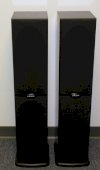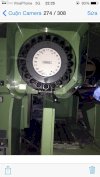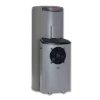Mô tả sản phẩm: M-Audio Firewire 410
The two inputs are quite versatile, each having a Neutrik combi socket on the front panel wired to accommodate either a balanced mic plugged into the outer XLR part or an unbalanced instrument (such as a guitar) plugged into the inner jack part. Separate quarter-inch jack sockets for unbalanced line-level signals are included on the rear panel, and are activated by pushing in the front-panel Mic/Line buttons. I much prefer this approach to switched sockets where plugging something into one deactivates the other, since you can leave both your mic/instrument and line sources plugged in and switch between them at will.
The low-noise mic preamps have a globally switched +48V phantom power option, and provide up to 66dB gain. There's also a switchable 20dB pad for each one, to cope with hotter signals (drum mics or guitars with active pickups, for instance), and each mic/instrument input has its own rotary gain control. The line-level inputs have a fixed sensitivity of -10dBV unaffected by the gain controls, and the input section is completed by a pair of front-panel LED indicators for each input which display Signal (around -30dB) and Clip (3dB below clip point) levels.
Next to the input controls on the front panel is a rotary control labelled Level Controller, described in the 410 manual as a "software-assigned rotary encoder for tactile control of monitor levels", which I'll come back to later. Atop this are eight output signal level 'blinkies' that flash when signals are present at each analogue output socket.
Twin stereo headphone outputs are next, each with its own rotary level control, although both carry the same signal. The final section on the front panel contains S/PDIF in and out signal indicators, a MIDI Thru switch which, when depressed, routes the MIDI input directly to the MIDI output for stand-alone use without a host computer, a switch and indicator for global +48V phantom power to both mic inputs, and a power switch.
This power switch has an associated blue LED indicator which also provides status information. Fast flashing indicates that the Firewire firmware isn't loaded, which can happen during the bootup process, slow flashing shows that the 410 has been detected but that it isn't yet switched on, while once you press the power button the 410 gets initialised and you should get a steady blue glow.
The rear panel contains the two line input sockets and eight line output sockets (all of which are on unbalanced quarter-inch jacks at -10dBV level), a pair of phono and a pair of Toslink optical sockets for the S/PDIF ins and outs, twin Firewire connectors, MIDI In and Out sockets, and a socket for the supplied but optional 12V DC power supply (see Powering The 410 box). Usefully, the labels for all the rear-panel I/O are duplicated at the back of the top panel to make it easier for you when working 'over the top'. The fact that there's a second Firewire socket on the back panel means you can still plug in an external Firewire hard drive if you're using a computer with only one socket of its own, although M Audio recommend that the 410 be the end device in a Firewire chain if possible.






















